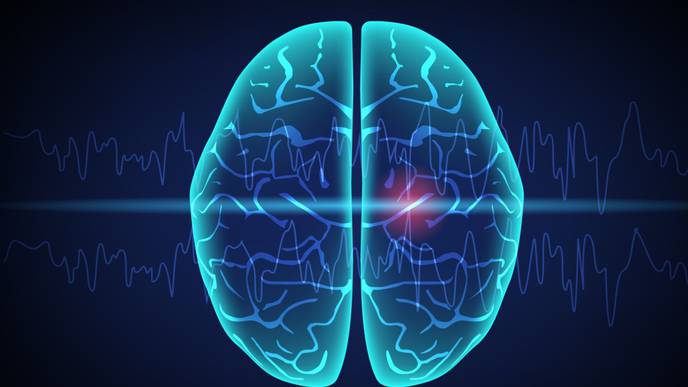ReachMD
Be part of the knowledge.™Gene Therapy May Be the First Step Toward Curing a Rare Genetic Epilepsy

Epileptic seizures are caused by networks of malfunctioning neurons, but Rubinstein hopes that correcting select neurons can improve the function of the whole network.
Dravet Syndrome is a rare genetic form of childhood epilepsy that affects less than 1 in 10,000 people in the United States. But, for affected children, the condition can delay normal development and affect lifelong outcomes.
Like many rare diseases, Dravet syndrome still lacks a cure, but a study recently published in the Journal of Clinical Investigation hopes to change that.1 The researchers show that gene therapy successfully reduces seizures in a mouse model of Dravet syndrome, making it a potential path to a cure.
“These rare diseases where you don't have an efficient pharmacological approach require out-of-the-box thinking,” said Eric Kremer, a virologist at the Institute of Molecular Genetics of Montpellier and one of the senior authors of this study. “You have to really go for the root cause of the disease.”
For Dravet syndrome, the root cause is usually a mutation in the SCN1A gene, which encodes a protein that helps sodium ions enter neurons. The mutations keep the protein from functioning properly, and when neurons cannot regulate the influx of sodium ions, the interconnected network of neurons in the brain can start malfunctioning and cause seizures.
Because of the clear genetic roots of Dravet syndrome, researchers have attempted to design gene therapies to bring the functional SCN1A gene into neurons, but they have encountered many technical hurdles.2 For example, one of the best known viral vectors for gene therapy is the adeno-associated virus, or AAV. However, it has limitations: it cannot hold a gene as large as SCN1A and it can trigger an immune response.
Moran Rubinstein, a neuroscientist at Tel Aviv University and one of the senior authors of this study, had engineered a mouse model of epilepsy in Dravet syndrome and wanted to use it to develop a gene therapy.3 So, she teamed up with Kremer, who had spent decades studying an alternate viral vector called canine adenovirus type 2 (CAV-2).4 This virus comes from dogs, so most humans do not have an immune response already built up against it. According to Kremer, compared to AAVs, it can store seven to eight times as much genetic material. In previous animal studies of other neurological diseases, he had found that CAV-2 was especially good at targeting neurons.5,6
Saja Fadila, first author of this study, tested the gene therapy in a mouse model of Dravet syndrome.
Photo credit: Saja Fadila
The researchers used CAV-2 to deliver the functional SCN1A gene into the brains of mice who were having seizures, targeting the hippocampus and thalamus regions that are known to be involved in Dravet syndrome. Within three days, neurons in these brain regions were no longer malfunctioning and the mice stopped having seizures and improved behaviorally. Rubinstein was surprised to see the therapy take effect so quickly. “With AAV, you would wait at least a week for some expression,” she said. “Here, within three days we had correction.”
Gabriele Lignani, a neuroscientist at University College London who was not involved in this study, was impressed by the researchers’ strategy of targeting specific brain regions. “That can maximize translation to patients,” he said. He still sees room for improvement in the viral vector and in determining which neurons to target.
The team will continue investigating this gene therapy to answer these lingering questions and others, such as how many neurons need to be treated to stop seizures. Rubinstein hopes that even targeting a few neurons could have a big effect on the network of neurons in the brain, and might even provide a path to treating epilepsy outside of Dravet syndrome.
“Once you go into the clinic, you don't go back to design a better tool,” Rubinstein said. “We hope to go to the clinic with the best possible tool offering a cure for Dravet syndrome.”
References
- Fadila S, Beucher B, González Dopeso-Reyes F, et al. Viral vector–mediated expression of NaV1.1, after seizure onset, reduces epilepsy in mice with Dravet syndrome.J Clin Invest. 2023;133(12):e159316.
- Chilcott E, et al. Genetic therapeutic advancements for Dravet Syndrome.Epilepsy Behav. 2022;132:108741.
- Fadila S, et al. Convulsive seizures and some behavioral comorbidities are uncoupled in the Scn1aA1783V Dravet syndrome mouse model.Epilepsia. 2020;61(10):2289-2300.
- del Rio D, Beucher B, Lavigne M. CAV-2 Vector Development and Gene Transfer in the Central and Peripheral Nervous Systems.Front Mol Neurosci. 2019;12:71.
- Lau AA, et al. Helper-dependent canine adenovirus vector-mediated transgene expression in a neurodegenerative lysosomal storage disorder.Gene. 2012;491(1):53-57.
- Mestre-Francés M, et al. Exogenous LRRK2G2019S induces parkinsonian-like pathology in a nonhuman primate.JCI Insight. 2018;3(14):e98202.
Facebook Comments